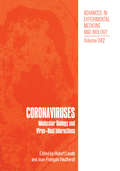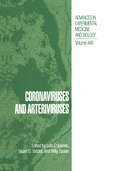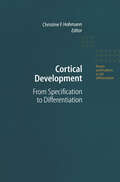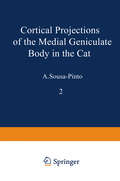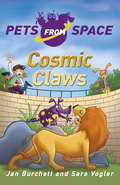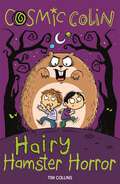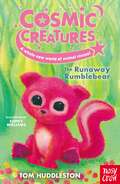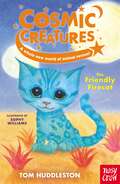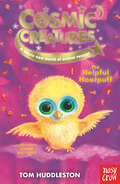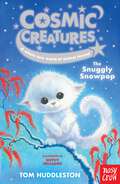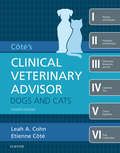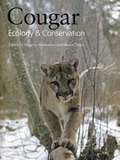- Table View
- List View
Cornish Castle Mystery Collection: Tales of murder and mystery from Cornwall
by Vivian Conroy‘Is yet another fantastic tale.’ Karen Quick ‘Guinevere is a little like a modern day Miss Marple’ Adele B The perfect cosy crime bundle, featuring both Cornish Castle mysteries. Welcome to Cornisea island and the mysteries surrounding the Cornish Castle…
Corona- and Related Viruses: Current Concepts in Molecular Biology and Pathogenesis (Advances in Experimental Medicine and Biology #380)
by Gary A. Levy Pierre J. TalbotCorona- and related viruses are important human and animal pathogens that also serve as models for other viral-mediated diseases. Interest in these pathogens has grown tremendously since the First International Symposium was held at the Institute of Virology and Immunobiology of the University of Wiirzburg, Germany. The Sixth International Symposium was held in Quebec City from August 27 to September I, 1994, and provided further understanding of the molecular biology, immunology, and pathogenesis of corona-, toro-, and arterivirus infections. Lectures were given on the molecular biology, pathogenesis, immune responses, and development of vaccines. Studies on the pathogenesis of coronavirus infections have been focused mainly on murine coronavirus, and mouse hepatitis virus. Neurotropic strains ofMHV (e.g., JHM, A59) cause a demyelinating disease that has served as an animal model for human multiple sclerosis. Dr. Samuel Dales, of the University of Western Ontario, London, Canada, gave a state-of-the-art lecture on our current under standing of the pathogenesis of JHM-induced disease.
The Coronaviridae (The Viruses)
by Stuart G. SiddellCoronaviruses were recognized as a group of enveloped, RNA viruses in 1968 and accepted by the International Committee on the Taxonomy of Viruses as a separate family, the Coronaviridae, in 1975. By 1978, it had become evident that the coronavirus genomic RNA was infectious (i. e. , positive strand), and by 1983, at least the framework of the coronavirus replication strategy had been per ceived. Subsequently, with the application of recombinant DNA techniques, there have been remarkable advances in our understanding of the molecular biology of coronaviruses, and a mass of structural data concerning coronavirus genomes, mRNAs, and pro teins now exists. More recently, attention has been focused on the role of essential and accessory gene products in the coronavirus replication cyde and a molecular analysis of the structure-function relation ships of coronavirus proteins. Nevertheless, there are still large gaps in our knowledge, for instance, in areas such as the genesis of coronavirus subgenomic mRNAs or the function of the coronavirus RNA-dependent RNA polymerase. The diseases caused by coronaviruses have been known for much longer than the agents themselves. Possibly the first coronavirus-related disease to be recorded was feline infectious peritonitis, as early as 1912. The diseases associ ated with infectious bronchitis virus, transmissible gastroenteritis virus, and murine hepatitis virus were all well known before 1950.
Coronaviruses: Molecular Biology and Virus-Host Interactions (Advances in Experimental Medicine and Biology #342)
by Hubert Laude Jean-Francois VautherotCoronaviruses represent a major group of viruses of both molecular biological interest and clinical significance in animals and humans. During the past two decades, coronavirus research has been an expanding field and, since 1980, an international symposium was held every 3 years. We organized the yth symposium for providing an opportunity to assess important progresses made since the last symposium in Cambridge (U. K. ) and to suggest areas for future investigations. The symposium, held in September 1992, in Chantilly, France, was attended by 120 participants representing the majOlity of the laboratories engaged in the field. The present volume collects 75 papers which were presented during the yth symposium, thus providing a comprehensive view of the state of the art ofCoronavirology. The book is divided into 7 chapters. The first chapters gather reports dealing with genome organization, gene expression and structure-function relationships of the viral polypeptides. New sequence data about as yet poorly studied coronaviruses - canine coronavirus CCY and porcine epidemic diarrhoea virus PEDY - are presented. Increasing efforts appear to be devoted to the characterization of products of unknown function, encoded by various open reading frames present in the coronavirus genomes or delived from the processing of the large polymerase polyprotein. Due to the extreme size of their genome, the genetic engineering ofcoronavi\'uses through the production of full length cDNA clones is presently viewed as an unachievahle task.
Coronaviruses and Arteriviruses (Advances in Experimental Medicine and Biology #440)
by Luis Enjuanes Stuart Siddel Willy SpaanProceedings of the VIIth International Symposium held in Segovia, Spain, May 10-15, 1997
Coronaviruses and their Diseases (Advances in Experimental Medicine and Biology #276)
by David Cavanagh T. David K. BrownInterest in the coronaviruses has never been greater. Their economic impact is considerable as they infect humans, livestock, poultry and companion animals. Murine hepatitis virus (MHV) infection of the mouse and rat central nervous systems are the subject of intense study; these investigations are providing insights into the potential role of viruses in human neurological diseases and, more generally, into mechanisms causing neurological damage. The single-stranded, positive-sense RNA genomes of two species of these enveloped viruses (IBV and MHV) have been cloned completely and one of them (lBV) sequenced in its entirety, revealing a genome size of some 27000 nucleotides. This has made possible more incisive investigations into the nature of those polypeptides, encoded by more than half of the genome, which are likely to contribute, in the main, to RNA polymerase/replicase activity. Intriguingly, ribosomal frameshifting is exhibited within the mRNA coding for these polypeptides. The cloning/sequencing phase of coronavirology for which the 1980's will be partly remembered, has provided a sound framework for furthex: studies of the virus structural proteins and also some provocative insights relevant to these studies. The large spike glycoprotein(s), responsible for membrane fusion and bearing important antigenic sites, varies amazingly in length and composition both within as well as between coronavirus species. Receptors on host cells have been identified. The integral membrane glycoprotein (M) has been shown to use internal hydrophobic sequences to direct translocation within membranes.
Corporate Diplomacy: Building Reputations and Relationships with External Stakeholders
by Witold J. HeniszManagers of multinational organizations are struggling to win the strategic competition for the hearts and minds of external stakeholders. These stakeholders differ fundamentally in their worldview, their understanding of the market economy and their aspirations and fears for the future. Their collective opinions of managers and corporations will shape the competitive landscape of the global economy and have serious consequences for businesses that fail to meet their expectations. This important new book argues that the strategic management of relationships with external stakeholders – what the author calls "Corporate Diplomacy" – is not just canny PR, but creates real and lasting business value.Using a mix of colourful examples, practically relevant tools and considered perspectives, the book hones in on a fundamental challenge that managers of multinational corporations face as they strive to compete in the 21st century. As falling communication costs shrink, the distance between external stakeholders and shareholder value is increasingly created and protected through a strategic integration of the external stakeholder facing functions. These include government affairs, stakeholder relations, sustainability, enterprise risk management, community relations and corporate communications. Through such integration, the place where business, politics and society intersect need not be a source of nasty surprises or unexpected expenses. Most of the firms profiled in the book are now at the frontier of corporate diplomacy. But they didn’t start there. Many of them were motivated by past failings. They fell into conflicts with critical stakeholders – politicians, communities, NGO staffers, or activists – and they suffered. They experienced delays or disruptions to their operations, higher costs, angry customers, or thwarted attempts at expansion. Eventually, the managers of these companies developed smarter strategies for stakeholder engagement. They became corporate diplomats. The book draws on their experiences to take the reader to the forefront of stakeholder engagement and to highlight the six elements of corprate diplomacy.
Corporate Diplomacy: Building Reputations and Relationships with External Stakeholders
by Witold J. HeniszManagers of multinational organizations are struggling to win the strategic competition for the hearts and minds of external stakeholders. These stakeholders differ fundamentally in their worldview, their understanding of the market economy and their aspirations and fears for the future. Their collective opinions of managers and corporations will shape the competitive landscape of the global economy and have serious consequences for businesses that fail to meet their expectations. This important new book argues that the strategic management of relationships with external stakeholders – what the author calls "Corporate Diplomacy" – is not just canny PR, but creates real and lasting business value.Using a mix of colourful examples, practically relevant tools and considered perspectives, the book hones in on a fundamental challenge that managers of multinational corporations face as they strive to compete in the 21st century. As falling communication costs shrink, the distance between external stakeholders and shareholder value is increasingly created and protected through a strategic integration of the external stakeholder facing functions. These include government affairs, stakeholder relations, sustainability, enterprise risk management, community relations and corporate communications. Through such integration, the place where business, politics and society intersect need not be a source of nasty surprises or unexpected expenses. Most of the firms profiled in the book are now at the frontier of corporate diplomacy. But they didn’t start there. Many of them were motivated by past failings. They fell into conflicts with critical stakeholders – politicians, communities, NGO staffers, or activists – and they suffered. They experienced delays or disruptions to their operations, higher costs, angry customers, or thwarted attempts at expansion. Eventually, the managers of these companies developed smarter strategies for stakeholder engagement. They became corporate diplomats. The book draws on their experiences to take the reader to the forefront of stakeholder engagement and to highlight the six elements of corprate diplomacy.
Cortical Development: From Specification to Differentiation (Results and Problems in Cell Differentiation #39)
by ChristineHohmannThe cerebral neo cortex, unique to mammals, is regarded as the prerequisite for higher cognitive function and is the structure most closely associated with the idea of the "mind" . Expansion of mental capa city between mammals is most typically associated with an evolutionary increase in neocortical volume that culminates in the intricately folded configuration of sulci and gyri so charac teristic of the primate cerebral cortex. Yet, the basic unit structure and funda mental connectivity of cortex appears to have been preserved from the smooth cortex of the mouse or rat to the highly convoluted cortical mantle of the human that, if stretched out as a sheet, would be large enough to wrap the entire human brain multiple times. The basic similarity in structure and func tion has made it possible to conduct studies in the relatively simple cortices of rat or mouse and have the results pertain to the understanding of the primate, including human, cortex. The neo cortex is an intriguing structure for the study of cell differentiation. Its dozens of neuronal cell types and small handful of different glial types have their origin in a pseudostratified germinal epithelium lining the ventricular surface of the forebrain. In its mature form, neocortex is a six-Iayered struc ture; five of its layers contain multiple different but characteristic neuronal types with the sixth occupied by neuronal processes. Various glial cells are dis persed throughout all six layers.
Cortical Projections of the Medial Geniculate Body in the Cat (Advances in Anatomy, Embryology and Cell Biology #48/2)
by A. Sousa-PintoCortico-Subcortical Dynamics in Parkinson’s Disease (Contemporary Neuroscience)
by Kuei-Yuan TsengThe striatum is the principal input structure of the basal ganglia. Numerically, the great majority of neurons in the striatum are spiny projection neurons, which produce the inhibitory output of the striatum to the globus pallidum and substantia nigra. The major glutamatergic afferents to the striatum from the cerebral cortex make monosynaptic contact with spiny projection neurons. The dopaminergic afferents from the substantia nigra also synapse directly on the spiny projection neurons. Thus, the spiny projection neurons play a crucial role in the input–output operations of the striatum by integrating glutamatergic cortical inputs with dopaminergic inputs and producing the output to other basal ganglia nuclei. Anatomical observations made nearly 30 years ago suggested that inhibitory interactions among the spiny projection neurons of the striatum are very pr- able. Individual spiny projection neurons produce a local axonal plexus in the spheroidal space occupied by their own dendritic trees [1, 2]. Based on the GABAergic nature of these neurons and their synaptic contacts with other spiny neurons, several authors have proposed that the spiny projection neurons form a lateral inhibition type of neural network [3–5]. In the idealised concept of lateral inhibition, each output neuron makes inhibitory synaptic contact with its neighbours [5]. However, there are physical limitations set by the extent of axonal and dendritic trees, and the number of synaptic sites, which mean that lateral inhibition is limited to a local domain of inhibition.
Cosmic Biology: How Life Could Evolve on Other Worlds (Springer Praxis Books)
by Louis Neal Irwin Dirk Schulze-MakuchIn Cosmic Biology, Louis Irwin and Dirk Schulze-Makuch guide readers through the range of planetary habitats found in our Solar System and those likely to be found throughout the universe. Based on our current knowledge of chemistry, energy, and evolutionary tendencies, the authors envision a variety of possible life forms. These range from the familiar species found on Earth to increasingly exotic examples possible under the different conditions of other planets and their satellites.Discussions of the great variety of life forms that could evolve in these diverse environments have become particularly relevant in recent years with the discovery of around 300 exoplanets in orbit around other stars and the possibilities for the existence of life in these planetary systems. The book also posits a taxonomic classification of the various forms of life that might be found, including speculation on the relative abundance of different forms and the generic fate of living systems. The fate and future of life on Earth will also be considered. The closing passages address the Fermi Paradox, and conclude with philosophical reflections on the possible place of Homo sapiens in the potentially vast stream of life across the galaxies.
Cosmic Claws: Book 2 (Pets from Space #2)
by Jan Burchett Sara VoglerLOOK OUT! The PETS FROM SPACE are back. If you don't like madness, mayhem and mischief then run away from this book! But if you love jokes, tricks and FUN then dive in!Tom, Zack and Daisy meet a new alien and take the Pets from Space to the wildlife park. What will happen when they meet elephants, penguins and lions? Will they be friends or will they be LUNCH?Each book features two fun stories, fully illustrated in black and white throughout by Alex Paterson.
Cosmic Colin: Hairy Hamster Horror
by Tim Collins John BigwoodWhen the spacebin lands on a strange planet where hamsters have developed into the dominant life form, Harry and Colin are in for another adventure. Unfortunately, the boys are captured by the humongous hamster hosts during a sightseeing trip to the Great Wheel of the Andromeda Galaxy. Harry and Colin are imprisoned as the school pets, bundled into a human-sized cage and forced to run on a giant wheel. Things go from bad to worse when the school's laziest hamster is charged with looking after Harry and Colin for the holidays. Will the adventurers find a way to escape from their hamster hell?This book is the third installment in the Cosmic Colin saga.
Cosmic Creatures: The Runaway Rumblebear (Cosmic Creatures #1)
by Tom HuddlestonOn a faraway planet, cute alien animals need help! Luckily, Charlie and her robot friend, Random, are ready for any rescue adventure...Something has been stealing the humans' food on planet Vela! Charlie discovers the thief - it's a cheeky, fluffy, hungry rumblebear! The rumblebear has lost its family, and Charlie is sure she can help it find them. But first, she'll have to hide the rumblebear from the angry mayor, and it's not easy to hide something that roars like a lion and won't stop eating!Fans of Zoe's Rescue Zoo and Holly Webb will love Cosmic Creatures! Beautifully illustrated throughout by Sophy Williams, Cosmic Creatures is perfect for animal-mad readers aged 5+.Look out for the other Cosmic Creatures stories:The Friendly Firecat
Cosmic Creatures: The Friendly Firecat (Cosmic Creatures #2)
by Tom HuddlestonOn a faraway planet, cute alien animals need help! Luckily, Charlie and her robot friend, Random, are ready for any rescue adventure...Charlie is on a special trip to see the migration of the firecats, the fastest animals on planet Vela! But when rustlers start kidnapping the cats, the herd stampede, and a sparkly little firekitten is left behind. Charlie and Random must come up with a plan to stop the rustlers and reunite the baby firecat with its family before it's too late...Fans of Zoe's Rescue Zoo and Holly Webb will love Cosmic Creatures! Beautifully illustrated throughout by Sophy Williams, Cosmic Creatures is perfect for animal-mad readers aged 5+.Look out for the other Cosmic Creatures stories!The Runaway Rumblebear
Cosmic Creatures: The Helpful Hootpuff (Cosmic Creatures #3)
by Tom HuddlestonOn a faraway planet, cute alien animals need help! Luckily, Charlie and her robot friend, Random, are ready for any rescue adventure...Charlie and Random discover an amazing underground cave filled with incredible animals. But the captain wants to start drilling for a new energy source. Charlie will have to think fast to save these cute creatures and their unusual home!Fans of Zoe's Rescue Zoo and Holly Webb will love Cosmic Creatures! Beautifully illustrated throughout by Sophy Williams, Cosmic Creatures is perfect for animal-mad readers aged 5+.Look out for the other Cosmic Creatures stories!The Runaway RumblebearThe Friendly Firecat
Cosmic Creatures: The Snuggly Snowpop (Cosmic Creatures #4)
by Tom HuddlestonOn a faraway planet, cute alien animals need help! Luckily, Charlie and her robot friend, Random, are ready for any rescue adventure... Charlie and her dad are on a mission with Captain Robertson to climb the highest mountain on planet Vela. When some very cute, very cheeky snowpops turn up and start to cause mischief, the captain is not amused. But a snowstorm threatens to put them all in danger. It's time for the snowpops to come to the rescue! Fans of Zoe's Rescue Zoo and Holly Webb will love Cosmic Creatures! Beautifully illustrated throughout by Sophy Williams, Cosmic Creatures is perfect for animal-mad readers aged 5+. Look out for the other Cosmic Creatures stories!The Runaway RumblebearThe Friendly FirecatThe Helpful Hootpuff
A Cosy Christmas in Cornwall
by Jane LinfootThe perfect cosy read for fans of Phillipa Ashley, Trisha Ashley and Holly Martin! A December to remember…
Cote's Clinical veterinary Advisor: Dogs and Cats - E-Book
by Leah Cohn Etienne CoteNEW! Expert Consult website with fully searchable eBook allows quick identification of any topic and its related information in the six different sections of the book. NEW! Fully revised and updated content plus dozens of all-new chapters, including: Hyperadrenocorticism (food-related) Meningoencephalitis of unknown etiology Hypercalcemia (feline idiopathic) Hops toxicosis Movement disorders Heart murmur (incidental finding) Polyneuropathy Urethral occluder placement Fecal transplant Bronchoalveolar lavage (blind) NEW! Informed client consent handouts provide simple explanations of procedures and denote foreseeable risks in both English and Spanish). NEW! Additional color images throughout the eBook increase the effectiveness of clinical photographs to showcase ophthalmologic and dermatologic conditions. NEW! Includes procedures and techniques rated in practical "do-ability" from 1 diamond (any vet should be able to read and do), to 3 diamonds (understanding procedure will facilitate conversation with clients but best performed through referral).
A Cotswold Family Life: heart-warming stories of the countryside from the bestselling author
by Clare MackintoshDon't miss the powerful and page-turning new novel from Clare Mackintosh - AFTER THE END is out now___________From bestselling author Clare Mackintosh, A Cotswold Family Life is a humorous, warm memoir of family life in the countryside'Insightful, funny, absorbing' Prue Leith'Original yet totally recognisable' Katie Fforde'Sheer bliss!' Jill Mansell'Heartfelt and poignant' Sunday ExpressI have always loved the Cotswolds. I think I loved them even before I found them, in that half-formed ideal one has of where to put down roots. Somewhere peaceful, green, where the road meanders between drystone walls and from town to town, and a strip of blue bursts from brook to river and back again. For 8 years, Clare Mackintosh wrote for Cotswold Life about the ups and downs of life with a young family in the countryside. In this memoir she brings together all of those stories - and more - for the first time. From keeping chickens to getting the WI drunk, longing for an Aga to dealing with nits, Clare opens the door to family life with warmth and humour and heart.
Cougar: Ecology and Conservation
by Maurice Hornocker Sharon Negri Alan RabinowitzThe cougar is one of the most beautiful, enigmatic, and majestic animals in the Americas. Eliciting reverence for its grace and independent nature, it also triggers fear when it comes into contact with people, pets, and livestock or competes for hunters’ game. Mystery, myth, and misunderstanding surround this remarkable creature. The cougar’s range once extended from northern Canada to the tip of South America, and from the Pacific to the Atlantic, making it the most widespread animal in the western hemisphere. But overhunting and loss of habitat vastly reduced cougar numbers by the early twentieth century across much of its historical range, and today the cougar faces numerous threats as burgeoning human development encroaches on its remaining habitat. When Maurice Hornocker began the first long-term study of cougars in the Idaho wilderness in 1964, little was known about this large cat. Its secretive nature and rarity in the landscape made it difficult to study. But his groundbreaking research yielded major insights and was the prelude to further research on this controversial species. The capstone to Hornocker’s long career studying big cats, Cougar is a powerful and practical resource for scientists, conservationists, and anyone with an interest in large carnivores. He and conservationist Sharon Negri bring together the diverse perspectives of twenty-two distinguished scientists to provide the fullest account of the cougar’s ecology, behavior, and genetics, its role as a top predator, and its conservation needs. This compilation of recent findings, stunning photographs, and firsthand accounts of field research unravels the mysteries of this magnificent animal and emphasizes its importance in healthy ecosystem processes and in our lives.
Cougar: Ecology and Conservation
by Maurice Hornocker Sharon Negri Alan RabinowitzThe cougar is one of the most beautiful, enigmatic, and majestic animals in the Americas. Eliciting reverence for its grace and independent nature, it also triggers fear when it comes into contact with people, pets, and livestock or competes for hunters’ game. Mystery, myth, and misunderstanding surround this remarkable creature. The cougar’s range once extended from northern Canada to the tip of South America, and from the Pacific to the Atlantic, making it the most widespread animal in the western hemisphere. But overhunting and loss of habitat vastly reduced cougar numbers by the early twentieth century across much of its historical range, and today the cougar faces numerous threats as burgeoning human development encroaches on its remaining habitat. When Maurice Hornocker began the first long-term study of cougars in the Idaho wilderness in 1964, little was known about this large cat. Its secretive nature and rarity in the landscape made it difficult to study. But his groundbreaking research yielded major insights and was the prelude to further research on this controversial species. The capstone to Hornocker’s long career studying big cats, Cougar is a powerful and practical resource for scientists, conservationists, and anyone with an interest in large carnivores. He and conservationist Sharon Negri bring together the diverse perspectives of twenty-two distinguished scientists to provide the fullest account of the cougar’s ecology, behavior, and genetics, its role as a top predator, and its conservation needs. This compilation of recent findings, stunning photographs, and firsthand accounts of field research unravels the mysteries of this magnificent animal and emphasizes its importance in healthy ecosystem processes and in our lives.
Country Affairs (The Tippermere Series)
by Zara Stoneley‘Eventing could definitely do with a few more Rory Steels!’ – Horse & Hound 'A great treat for readers…jam-packed with sexy men and horses' Bestselling author Fiona Walker Welcome to Tippermere for the wedding of the year…
Country Rivals (The Tippermere Series)
by Zara StoneleyA hilarious, sexy rom com for fans of Jilly Cooper and Fiona Walker!



